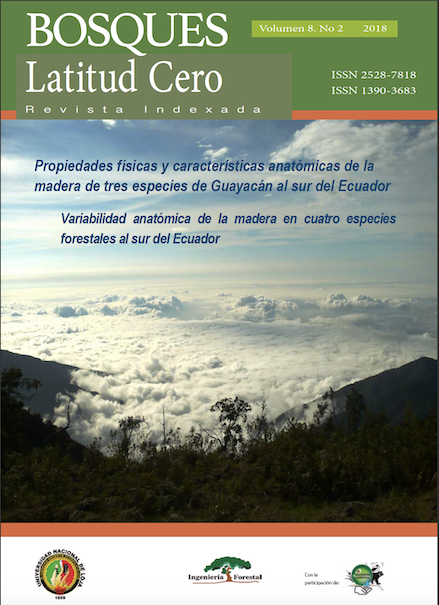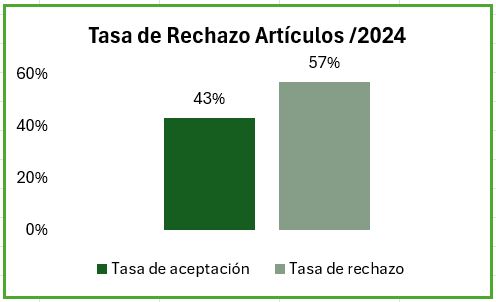Propiedades físicas y características anatómicas de la madera de tres especies de Guayacán al sur del Ecuador
Palabras clave:
Guayacán, Handroanthus chrysanthus, billbergii, serratifolius, propiedades físicas, anatomía maderaResumen
El estudio se realizó en el bosque seco del sur de Ecuador, en los sectores Mangahurco, Nueva Fátima y Santa Lucía. Se estudiaron tres especies: Handroanthus chrysanthus, Handroanthus billbergii, y Handroanthus serratifolius. Probetas de madera fueron obtenidas del fuste de árboles individuales considerando características biogeográficas del sitio, y parámetros dasométricos. De cada probeta se determinó las características organolépticas, macroscópicas, y microscópicas de la madera. Existe transición abrupta entre el color del duramen (marrón) y la albura (marrón amarillento) de las tres especies. Se encontraron notables diferencias en las características de la madera, H. chrysanthus del sector Nueva Fátima presentó valor más alto de contenido de humedad (18,54 %) y no mostró contracciones de su madera, mientras que H. serratifolius tiene mayor densidad básica. Respecto a las características anatómicas la mayoría de especies mostraron parénquima axial de tipo paratraqueal, confluente, unilateral paratraqueal y en bandas finas, así como reticulado y escaliforme, y placas de perforación simples con punteaduras intervasculares poligonales alternas. H. billbergii, presentó fibras con pared celular muy gruesas, y H. chrysanthus de Nueva Fátima mostró células de tipo fusiforme de ocho células por hebra de parénquima. Una notable diferencia se observó en los radios, donde H. chrysanthus y H. serratifolius presentaron radios de 1 a 3 series, y H. billbergii fue la única que mostró radios exclusivamente uniseriados, elemento clave para la diferenciación de especies forestales a través de una muestra de madera. Por lo tanto, este estudio sienta las bases para la identificación de especies forestales a través de sus características microscópicas y anatómicas de la madera, especialmente las de alto valor comercial al sur de Ecuador.Palabras clave: Guayacán, Handroanthus chrysanthus, billbergii, serratifolius, propiedades físicas, anatomía madera. .Citas
Aguirre- Mendoza Z., Loja A., Solano M, y Aguirre N. (2015). Especies Forestales más aprovechadas del Sur de Ecuador. Universidad Nacional de Loja. Ecuador. 128p.
Aguirre, Zhofre. (2015). Pasado, presente y futuro de los “guayacanes” Handroanthus chrysanthus (Jacq.) S. O. Grose y Handroanthus billbergii (Bureau y K. Schum.) S. O. Grose, de los bosques secos de Loja, Ecuador. Arnaldoa. 22(1): 85-104.
Barghoorn, W., Cabrera, D. y Alvarado, P. (1967). Estudio orientativo de algunas propiedades anatómicas y físico -mecánicas de 41 especies maderables de la región Carare – Opón. Instituto de Investigaciones y Proyectos Forestales y Madereros de La Universidad Distrital. Bogotá, Colombia.
Corothie, H. (1948). Maderas de Venezuela. Ministerio de Agricultura y cría. Universidad de Michigan.
Chavesta, M. (2005). Maderas para pisos. Facultad de Ciencias Forestales, Universidad Nacional Agraria La Molina. Perú.
Chavesta, M. (2006). Separata de capacitación sobre identificación de madera. Perú. 8-13.
De Muñiz, G. I. B., y Marchiori, J. N. C. (2009). Anatomía da madeira de duas Bignoniáceas da Floresta Estacional de Misiones– Argentina. Balduinia, (18): 20- 25.
E. (Eds.). (1989). IAWA list of microscopic features for hardwood identification. Repr. IAWA Journal 10: 219-332.
Kribs, D. 1950. Comercial Foreign Word on the American Market. Dower Publication. Inc the Pensylvania State University. New Cork, United States.
González, A. (2013). Indumento, nectarios extraflorales y anatomía foliar en Bignoniaceas de la Argentina.
Grande, D., Polanco, C. (2007). Descripción anatómica de la madera de cuarenta especies del bosque Alto-Andino en GUASCA, Cundinamarca. Colombia Forestal. 10 (20): 180-206
Grose, S y Olmsted R. (2007). Taxonomic revisions in the polyphyletic genus Tabebuia s.1. (Bignoniaceae). Department of Biology, University of Washington. Systematic Botany, 32 (3): 660-670.
Ibáñez, C. (2001). La Madera: Composición, alteraciones y restauración. Recuperado de: https://grupos.unican.es/acanto/ aep/bolpas/la_madera_BMVP- 2001.htm
Leonardi, D., Sapio, O., Gattuso, M. y Gattuso S. (2002). Caracteres morfoanatómicos de la corteza y hojas de Tabebuia impetiginosa y T. heptaphylla (Bignoniaceae). Sociedad Argentina de Botánica. 37 (1-2): 51-61
León, W. (2007). Anatomía del Xilema Secundario de 10 especies de la familia Bignoniaceae de Venezuela. Universidad de los Andes. Mérida, Venezuela.
León, W. (2009). Anatomía de la Madera y Clave de Identificación para Especies Forestales Vedadas en Venezuela. Revista Forestal Venezolana, 51-62.
León, W. (2014). Anatomía de maderas de 108 especies de Venezuela. Universidad de los Andes, Revista Pittierria.
Marchiori, J. N. C. (2009). Estudo anatômico da madeira de Handroanthus pulcherrimus (Sandwith) S. Grose. Balduinia, (19): 10-13.
Morris, C. y Rey, J. (1974). Clave macro y micrográfica de catorce (14) maderas colombianas. Tesis de grado. Ingeniería forestal. Universidad Distrital Francisco José de Caldas. Santafé de Bogotá.
Nutsch, W. (1999). Tecnología de la madera y mueble. Editorial Reverté, S.A.
Parolin, P. (2002). Radial gradients in wood specific gravity in trees of Central Amazonian Floodplains. IAWA Journal. (23): 449-457.
Pérez, A. (1987). La identificación anatómica de maderas en Latinoamérica. Acta Botánica Brasilica. (2): 291-297.
Pineda, S., León, W., y Valero, S. (2016). Madera de frondosas: cedro, apamate, curarire y divi, utilizadas en armaduras de cubiertas y carpintería de las viviendas de mampostería del casco histórico de Maracaibo, Ve-nezuela. Revista electrónica ReCoPar, (11): 18-38.
Rodríguez, R., Palacios, H y Lomelí M. (2007). Estructura anatómica de la madera. Ciencia y Desarrollo. 33 (213): 24-29.
SENA. (2012). Guayacán, Polvillo (Tabebuia serratifolia). Disponible en: http://www.cmm.com.co/assets/pdf/Guayacan_Polvillo_(Tabebuia_serratifolia).pdf
Silva, J. (2009). Determinación de las características anatómicas y propiedades físicas de la madera de la especie forestal madero negro o guayacán (Tabebuia billbergii) de la región Tumbes. Tesis Ingeniero Fores-tal, Facultad de Ciencias Agrarias. Escuela de Ingeniería Forestal y Medio Ambiente, Universidad Nacional de Tumbes. Perú. 130p.
Villalba, H. (2010). Materiales de uso técnico. La Madera. Disponible en: https://iesvillalbahervastecnologi a.files.wordpress.com/2010/02/ materiales_madera.pdf
Vinueza, M. (2012). Fichas técnicas de especies forestales. Ficha técnica Nº 6: Guayacán. Ecuador Forestal. Disponible en: https://ecuadorforestal.org/fichas-tecnicas-de-especies-forestales/ficha-tecnica-no-6-guayacan/
Zapater, M. y Lozano, E. (2009). Delimitación y estatus de Handroanthus heptaphyllus y H. impetiginosus (Tecomae, Bignoniaceae). Darwiniana. 46 (2): 304-317
Zapater, M., Califano, L., Castillo, E., Quiroga, M. y Lozano, E. (2009). Las Especies Nativas Y Exóticas De Tabebuia Y Handroanthus (Tecomae, Bignoniaceae) En Argentina. Darwiniana. 47 (1): 185 -220.
Descargas
Publicado
Cómo citar
Número
Sección
Licencia
Derechos de autor 2018 Bosques Latitud Cero

Esta obra está bajo una licencia internacional Creative Commons Atribución-NoComercial-CompartirIgual 4.0.
Esta obra se publica bajo la licencia Creative Commons Atribución-NoComercial-CompartirIgual 4.0 Internacional (CC BY-NC-SA 4.0). Esto significa que los usuarios pueden copiar, distribuir y adaptar el contenido, siempre que se otorgue el crédito adecuado a los autores y a la revista. No se permite el uso comercial del material. Además, cualquier obra derivada debe distribuirse bajo la misma licencia. Esta licencia garantiza el acceso abierto al conocimiento, promoviendo la difusión y reutilización de los trabajos publicados sin fines de lucro, respetando la autoría y asegurando la libre circulación del contenido en términos equitativos.






























